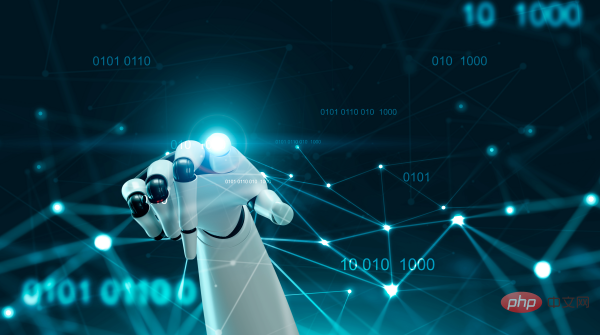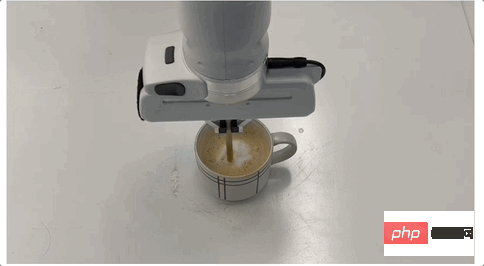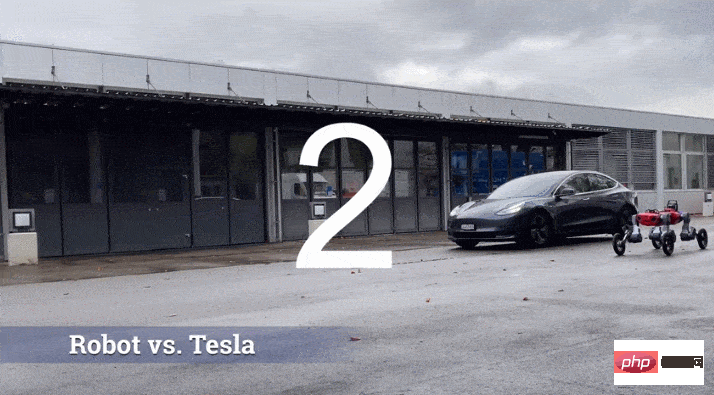 Technology peripherals
Technology peripherals AI
AI Is the U.S. far behind in robot applications? After 15 years, ten top universities restarted the 'National Robotics Roadmap”
Is the U.S. far behind in robot applications? After 15 years, ten top universities restarted the 'National Robotics Roadmap”Robotics technology has a history of 70 years, and the United States has been leading the way since its inception.
As of 2009, when the United States released the National Robotics Roadmap for the first time, the United States’ application in industrial applications (such as automobiles, aerospace, and home appliances, etc.) has been reduced to the global fourth place.
Since 2015, the United States has continued to increase its adoption of robotics technology, ranking tenth in the world. The Asian robot market has expanded by 5-10% of the U.S. market. times.
China is "far ahead" in this field. In 2023, China purchased approximately 52% of robots sold, indicating that robotics is no longer a national priority in the United States. .
Recently, ten top American universities including the University of California, the University of Pennsylvania, the University of Texas at Austin, and General Electric Vernova jointly released the latest version of the U.S. Robot Roadmap, which lasts for 70 years. page, which summarizes 60 two-page white papers from industry and academia, providing guidance and planning for the future development direction of robotics technology.
 Picture
Picture
Paper link: https://hichristensen.com/pdf/roadmap-2024.pdf
The roadmap begins by discussing the major trends that will have a broad impact on society as a whole in the next decade. These trends are key factors in shaping the future and have nothing to do with the development of robotics, but are the key factors in building the future of technology. Foundation.
The main business drivers for future robotics applications are then discussed in detail, covering a number of different industries from manufacturing to healthcare and leisure, revealing not only what drives economic growth but also The main factors of industrial opportunities are also pointed out the business potential behind these factors.
Then he also pointed out the challenges faced in realizing these business opportunities, including advances in material science, convenience of data acquisition, innovation in computing technology, and innovation in user interfaces. , also means that further research and development (R&D) is needed to overcome.
Finally, the article puts forward the main issues that need to be solved in order to maintain the growth momentum, which will guide future research directions and policy formulation and ensure that the United States maintains its leadership position in the field of global robotics. Specifically, Achieving this will require a series of actions and initiatives to address challenges, seize opportunities, and advance robotics to ensure America’s competitive advantage around the world.
Chinese robot companies can also find inspiration from this roadmap and think about countermeasures to expand the market.
Abstract
The field of robotics is at a turning point. Component technologies such as materials, embedded systems and artificial intelligence are experiencing exponential growth, which in turn is catalyzing the development of robotics. Significant progress. The field is changing rapidly, both in terms of scientific advancements and new applications, and robotics will have a profound impact on our daily lives in the coming years, from home to work to leisure activities.
As of today, 82% of the world’s population already lives in urban environments, and it is expected to increase to 90% by the middle of this century. This will undoubtedly have an impact on infrastructure, logistics, construction and safety, and everything from manufacturing to services to home activities and leisure will benefit from the use of automation and robotics.
Social trends also clearly point out the need to increase the use of robotics technology. For example, it is necessary to relocate manufacturing industries such as automobiles and semiconductors to the United States.
Moreover, after the COVID-19 epidemic, society has a labor shortage problem. According to data from the Federal Reserve System, only seven workers are available for every ten open industrial jobs. If there are no "tools" to Increase productivity and economic growth will be seriously threatened.
The working population is also aging at a rate of 8 hours a day, which means that the labor force will decrease over time, and the number of people over 65 years old will increase significantly, which will have a significant impact on Challenges arise for the health care system and for those who wish to remain in their own homes for extended periods of time to maintain quality of life.
In a world of rapid technological change, society also needs mechanisms to continuously provide workforce training to maintain and promote economic growth.
Over the past four years, the U.S. National Robotics Program has ended, the Congressional Caucus on Robotics has had no activity (the last event was in May 2019), and national agencies have Investments in robotics so far have been mostly uncoordinated and small-scale investments.
There are signs that robotics is no longer a national priority in the United States, posing risks to the United States’ long-term competitiveness.
Main Recommendations
In the past four years, the National Robotics Initiative (NRI) was terminated.
In 2011, NRI was initially created as a multi-agency research and development program involving the National Science Foundation (NSF), the United States Department of Agriculture (USDA), the U.S. The National Institutes of Health (NIH), the National Aeronautics and Space Administration (NASA), and later the National Institute of Standards and Technology (NIST) and other federal agencies also joined in.
Now, there is a need for a program like NRI that is supported by multiple agencies and has a cross-agency application.
The effectiveness of NRIs has been proven, and when implemented, the process is more efficient: in standard funding models, applications are often rejected because they are not a good fit for a specific program or institution Being rejected leads to reduced innovation efficiency.
Socio-economic-technological ecosystems are dynamic, complex, and interconnected, connecting "research and development" to real-world, large-scale In practical implementation, federal investment in research and development can achieve the greatest social benefit only if the entire ecosystem is fully considered during the initial design.
Now there is a need to quickly bring practical implementation insights back into research and development programs to minimize waste and maximize success.
The researchers recommend creating a system that includes those responsible for economic competitiveness (U.S. Department of Commerce, Department of Transportation, Federal Aviation Administration), health (Department of Health and Human Services) and safety (Department of Defense, Department of Defense, Federal Aviation Administration) Department of Energy), and an interagency working group with representatives from key research and development agencies (NSF, DOE, DOD, NIST).
The working group will be responsible for ensuring that the design and implementation of research programs are closely linked to development and demonstration programs and should bring together project managers and executors from academia, industry and government. , to increase communication and connections across the entire ecosystem.
The working group should liaise with other interagency working groups (e.g., Artificial Intelligence, NITRD) to ensure coordination and reduce duplication of efforts.
During the last roadmap cycle (2020-2024), the Congressional Robotics Caucus was disbanded, and researchers recommended reactivating the caucus.
Given all the societal benefits outlined in this report, it is critical that robotics becomes a national priority.
There is now a Congressional Artificial Intelligence Caucus, which is somewhat laudable, but many key parts of robotics, such as mechanical design, soft robotics, and control, are not directly governed by AI. As covered by the core group and other committees, interaction with the physical world is at the core of robotics, distinguishing robotics from artificial intelligence while also making it complementary to modern artificial intelligence.
Also need to consider how to support industry in the development, adoption and use of robotics. This should be through programs such as the National Manufacturing Institute, SBIR program, etc., but there should also be more Many targeted plans.
Finally, training and retraining the workforce is critical.
There is already a significant labor shortage in society, and as demographics evolve, this issue will become an even greater priority.
Without an adequate and trained workforce, quality of life and economic growth will be challenged, and the United States needs to invest in training and education in technical schools, colleges, and continuing education programs.
In short,
1. Robotics will transform society and may become as ubiquitous within the next decade as computer technology is today. It seems that the United States is developing too slowly at present, so robotics should once again become a national government priority;
2. There should be funding for robotics R&D (research and development), innovation and Leveraging cross-agency coordination and a comprehensive perspective across industry, academia, and government is critical for the United States;
3. The Congressional Robotics Caucus should be reactivated to ensure that all levels Prioritize appropriately;
4. Funding programs across agencies need to be unified so that researchers, developers, and entrepreneurs have easier access to these opportunities;
5. Need to consider mechanisms to support U.S. industry to remain competitive across regions and countries;
6. Need to focus more on workforce training to address shortages, And make sure you adapt to new technologies.
Directory
 Pictures
Pictures
 ##Pictures
##Pictures

The above is the detailed content of Is the U.S. far behind in robot applications? After 15 years, ten top universities restarted the 'National Robotics Roadmap”. For more information, please follow other related articles on the PHP Chinese website!
 机器人学我表情的样子,让人感到一丝恐惧Apr 09, 2023 am 10:11 AM
机器人学我表情的样子,让人感到一丝恐惧Apr 09, 2023 am 10:11 AM通常,机器人的主要功能是完成一些简单的操作任务,我们希望机器人可以模仿人,让能力尽可能接近人类水平。不论是小米的 CyberOne 还是特斯拉的 Optimus,人们关心的主要是其机械关节数量,控制算法和行走速度。不过在这个领域,有些人探索的方向更加脑洞大开:现在,有一种机器人把模仿真人表情做到了极致:先尝试一下自拍。从「嫌弃」到「惊讶」,都可以做到完全同步:这个机器人名叫 Ameca,是个表情怪。除了模仿,它自己也能照镜子做很多小表情,看起来非常像真人。Ameca「假装」第一次见到镜子,首
 拿破仑、孔子在线陪聊!AI聊天机器人「复活」历史名人,网友:真上头!Apr 08, 2023 pm 12:11 PM
拿破仑、孔子在线陪聊!AI聊天机器人「复活」历史名人,网友:真上头!Apr 08, 2023 pm 12:11 PM和活生生的已故历史名人聊天是个什么感觉?近日,就有一群开发者利用语言模型,把千百年来各行各业的历史名人全部「复活」成了聊天机器人,做进了一款手机app里,起名叫「你好,历史」!开发者声称,这个与古代名人聊天的app涉及的内容几乎无所不包。比如可以:与玛丽莲·梦露聊好莱坞八卦与弗里达·卡洛讨论现代艺术问问圣诞老人他有多少只驯鹿问问科特·科本为什么自杀向穴居人学习如何生火与宇宙意识辩论生命的意义不过他们也没忘记提醒用户,这些对话是由人工智能生成的,所以不要太认真。而且每个对话都是独一无二的,你永远不
 女王登基70周年,世上首个超逼真人形机器艺术家献上肖像画作,被锐评“缺少信念”Apr 08, 2023 pm 08:11 PM
女王登基70周年,世上首个超逼真人形机器艺术家献上肖像画作,被锐评“缺少信念”Apr 08, 2023 pm 08:11 PM大数据文摘出品作者:Caleb为庆祝英国女王伊丽莎白二世登基70周年,英国也是早早就洋溢出了庆典的味道。据了解,英国将于6月2日至5日连放4天公众假期,并在期间举行多项庆祝活动。英国皇家铸币厂也在精心打造有史以来最大的硬币,直径220毫米,重15公斤,面值15000英镑,耗时近400小时打造,是该厂1100年来生产的最大硬币。这枚金币一面雕刻着代表英国女王伊丽莎白二世的符号EⅡR,周围环绕着代表英国的玫瑰、水仙、蓟和三叶草。另一面有女王骑在马背上的图案。在这么热闹的日子里,AI当然也必须来凑一凑
 人类与人工智能如何建立关系Apr 09, 2023 pm 07:41 PM
人类与人工智能如何建立关系Apr 09, 2023 pm 07:41 PM人类与人工智能相比,哪个更擅长建立关系?事实上,这项革命性的技术已经存在了很长一段时间。然而,直到最近人们才意识到人工智能对人类的重要性。人工智能利用算法模拟人类,并随着时间的推移从经验中学习的能力,为这项技术与人类建立关系开辟道路。人类如何建立人际关系作为人类,我们倾向于只与少数人建立关系。我们试图确保不需要的和不相干的人从我们的生活中消失。在将我们的关系限制在少数人的同时,我们确保与那些对我们真正重要的人建立高质量的关系。然而,同样的方法在商业用语中可能不是理想的,并可能适得其反。尽管知道这
 盘点全球不错的七所机器人工程专业学校Apr 08, 2023 pm 01:31 PM
盘点全球不错的七所机器人工程专业学校Apr 08, 2023 pm 01:31 PM有抱负的工程师应该了解世界各地著名的机器人工程学院。现在是从事机器人和工程事业的最佳时机——从人工智能到太空探索,这一领域充满了令人兴奋的创新和进步。美国劳工统计局估计,未来10年,机械工程领域的职业总体上将保持7%的稳定增长率,确保毕业生将有大量的就业机会。机器人工程专业的学生平均工资超过9万美元,无需担心还助学贷款的问题。对于那些考虑投身机器人工程领域的人来说,选择一所合适的大学是非常重要的。世界上许多顶尖的机器人工程学院都在美国,尽管国外也有一些很棒的项目。这是7所世界上最好的机器人工程学
 让机器人学会咖啡拉花,得从流体力学搞起!CMU&MIT推出流体模拟平台Apr 07, 2023 pm 04:46 PM
让机器人学会咖啡拉花,得从流体力学搞起!CMU&MIT推出流体模拟平台Apr 07, 2023 pm 04:46 PM机器人也能干咖啡师的活了!比如让它把奶泡和咖啡搅拌均匀,效果是这样的:然后上点难度,做杯拿铁,再用搅拌棒做个图案,也是轻松拿下:这些是在已被ICLR 2023接收为Spotlight的一项研究基础上做到的,他们推出了提出流体操控新基准FluidLab以及多材料可微物理引擎FluidEngine。研究团队成员分别来自CMU、达特茅斯学院、哥伦比亚大学、MIT、MIT-IBM Watson AI Lab、马萨诸塞大学阿默斯特分校。在FluidLab的加持下,未来机器人处理更多复杂场景下的流体工作也都
 四足机器人学会“双腿站立下楼梯”!效率比腿式系统高83%Apr 09, 2023 am 11:21 AM
四足机器人学会“双腿站立下楼梯”!效率比腿式系统高83%Apr 09, 2023 am 11:21 AM还记得那个和特斯拉飙车的机器人吗?这是瑞士苏黎世联邦理工学院衍生公司研发的与公司同名的四足轮腿式机器人——Swiss-Mile,前身是ANYmal四足机器人。距离它和特斯拉飙车还不到半年的时间,它又实现了重大升级。这次升级改进了机器人的算法,运动能力直接UP UP UP ! 可以双腿站立下楼梯:(小编内心OS:如果是我穿轮滑鞋下楼梯可能会摔个狗吃屎)楼梯爬累了,坐个电梯吧,用前脚按开电梯门:面对障碍物应对自如:它还能知道什么时候该站起来,什么时候该“趴下”,双腿直立与四足运动之间的切换更丝滑:
 科学家展示世界上有史以来超小的“螃蟹”遥控步行机器人,体积比跳蚤还小Apr 09, 2023 pm 10:41 PM
科学家展示世界上有史以来超小的“螃蟹”遥控步行机器人,体积比跳蚤还小Apr 09, 2023 pm 10:41 PM日前,美国西北大学工程师开发出有史以来最小的遥控步行机器人,它以一种小巧可爱的螃蟹形式出现。这种微小的“螃蟹”机器人宽度只有半毫米,可以弯曲、扭曲、爬行、行走、转弯甚至跳跃,无需液压或电力。IT之家了解到,相关研究成果发表在《科学・机器人》上。据介绍,这种机器人是用形状记忆合金材料所制造的,然后可以变成所需的形状,当你加热后又会变回原来的形状,而热量消失时可以再次弹回变形时的样子。据介绍,其热量是由激光所带来的。激光通过“螃蟹”加热合金,但因为它们非常小,所以热量传播非常快,这使得它们的响应速度


Hot AI Tools

Undresser.AI Undress
AI-powered app for creating realistic nude photos

AI Clothes Remover
Online AI tool for removing clothes from photos.

Undress AI Tool
Undress images for free

Clothoff.io
AI clothes remover

AI Hentai Generator
Generate AI Hentai for free.

Hot Article

Hot Tools

WebStorm Mac version
Useful JavaScript development tools

mPDF
mPDF is a PHP library that can generate PDF files from UTF-8 encoded HTML. The original author, Ian Back, wrote mPDF to output PDF files "on the fly" from his website and handle different languages. It is slower than original scripts like HTML2FPDF and produces larger files when using Unicode fonts, but supports CSS styles etc. and has a lot of enhancements. Supports almost all languages, including RTL (Arabic and Hebrew) and CJK (Chinese, Japanese and Korean). Supports nested block-level elements (such as P, DIV),

Dreamweaver CS6
Visual web development tools

PhpStorm Mac version
The latest (2018.2.1) professional PHP integrated development tool

MinGW - Minimalist GNU for Windows
This project is in the process of being migrated to osdn.net/projects/mingw, you can continue to follow us there. MinGW: A native Windows port of the GNU Compiler Collection (GCC), freely distributable import libraries and header files for building native Windows applications; includes extensions to the MSVC runtime to support C99 functionality. All MinGW software can run on 64-bit Windows platforms.





